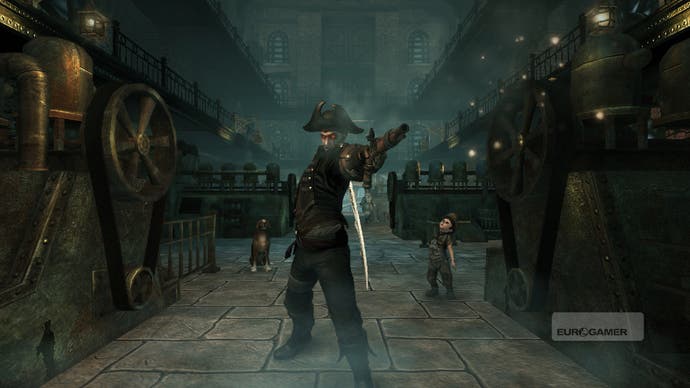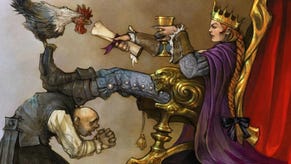Fable III
You rule.
You can use Touch in any situation, in combat, when you're king - dragging characters to dungeons or the gallows. Molyneux hopes Touch will drive home the emotional weight of such decisions, and says it's absolutely central to Fable III. "Touch is the first thing taught in the game," he says. "You can apply that trigger anywhere, at any time."
He's evasive on how it will be controlled, however. There will be visual cues not in the current build of the game, such as glows around people you can touch, and "we've replaced functionality of the A button to an extent", but it's not clear how you'll be able to change the tone of your physical interactions. This is one area of the game where the promised support of Natal, Microsoft's new motion-sensing device, might come into play.
Combat is "a lot simpler and more accessible," says Molyneux, with a one-button system that unleashes light attacks with fast taps and heavier ones you build up by holding the button down. This isn't capped at all, so you could hold down the button for hours to deliver a "thermonuclear explosion" if you wanted, and the same system works across melee weapons, guns and magic.
In the demo, a half-naked hero with a giant axe who's clearly taken the evil path butchers opponents with heavy, slow-motion finishing blows. We're in a dungeon, a huge, high, open and atmospheric cave that will be fully navigable. There's a surprising amount of blood spattering about; the gore level adjusts to your moral alignment since, quite simply, evil players of the previous games wanted to see more blood, and good players wanted to see less. Phantom wings flash behind the hero as he strikes, the size and colour of which will show your power level and alignment.

But that's just the least of the visual representations of your achievements and choices in Fable III. As in its predecessors, your character will morph, but instead of physical attributes being dictated by stats (a particular problem with female avatars who tended to end up looking like "shot-putters", Molyneux says) they will be influenced by weapon choice.
"If you want to be big and strong use a big weapon. If you want to be lithe and slender and graceful, use pistols and swords. If you want to be magical and mysterious, use magical objects like rings."
In the game's most visually striking change, those weapons (including magical objects) will now morph with you. They'll be unique, bearing your gamertag and changing according to how they've been used, and how much.
They'll have their own alignment, dripping with blood or glowing with a holy aura depending on how many innocents they've killed. Very aligned weapons will start singing of things that have happened to them when you take them out, a reference to Michael Moorcock.
Weapons' size is dictated by the number of kills and appearance by what enemies they've slaughtered - an axe that has killed a lot of Hobs will look like it's made out of Hob parts. They'll even have detailing drawn from your gamerscore.

"We're just bored of making more weapons for you," Molyneux says. He recalls how dispirited the team at Lionhead got when considering the 200 weapons they were going to have to design to beat Fable II's tally of 150. "People are going to be bored," he remembers thinking. "Why don't we get you, the gamer, to craft the weapons? You craft them by using them. Any weapon will reflect the way you use it and what you've done with it."
You can even trade a weapon online, selling to other players in whose hands it will continue to grow and change, although it will always bear your name. We ask if this means there'll be some sort of auction house, an economy tying Fable III's players together, but Molyneux, with a visible effort, dodges the question. "Something like that," he says, explaining that he can't go any further without digging into the online side of Fable III for which Lionhead appears to have very big plans that it's not ready to talk about.
He does mention that online co-op is a "really big feature"; that Touch can be used with other players invited into your world, and that you can even marry them; that they'll bring their own morphed weapons and dog with them into your world; and that players will no longer be tied to a single camera or area, but will be able to split up and do entirely separate things within the same game world.
If Lionhead can make this most individual and personalised of RPGs a truly social, connected game - something it never quite managed to do with Fable II - it will be a great achievement. We're anxious to know more, but in truth, our heads are already spinning.
It was a typically Molyneux presentation, stronger in suggestion and rhetoric than hard detail. But Fable III's ideas are bold and clear, and the game on the screen was solid and handsome and bursting with character. The king might just have found his crown.
Fable III is due out exclusively for Xbox 360 this "holiday season".








